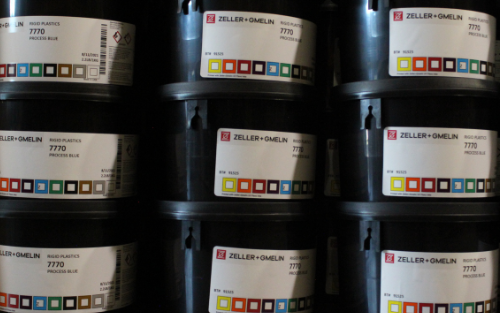Sobrevivir el verano en la sala de prensa: Cómo proteger la adhesión de la tinta y la calidad de la etiqueta
A medida que aumentan las temperaturas, Los desafíos relacionados con el calor en la sala de prensa también lo hacen. Para impresoras de etiqueta, El clima de verano puede traer una serie de variables que amenazan el rendimiento de la prensa, eficiencia, y calidad de impresión.
Ya sea que esté funcionando con tintas a base de agua o UV/LED, El calor y la humedad tienen un efecto directo en el rendimiento, Desde la adhesión de la tinta hasta el manejo del sustrato. Abajo, Nos sumergimos en tres desafíos clave que surgen en los meses de verano, y las recomendaciones de nuestro experto para ayudarlo a superar el calor.
Peligros de humedad en la transferencia de tinta y adhesión
Hay dos formas en que la humedad puede interrumpir su rendimiento de impresión. El obvio es las condiciones bordadas en las tiendas sin control climático. Pero incluso si estás golpeando el calor por dentro con aire acondicionado y deshumidificadores, A medida que trae sus rollos de material de camiones de reparto afuera y colóquelos en el taller, Es posible que se enfrente a algunos problemas de condensación, especialmente si esos materiales se colocan directamente en la prensa sin tener tiempo para adaptarse a la nueva temperatura ambiente.
No importa cuán humedad se introduzca en su proceso de impresión., Puede conducir a una disminución en la energía superficial de su sustrato que conduce a una mala adhesión de tinta, moteado, u otros problemas de tinta. Evite las inconsistencias de calidad y los desechos materiales debido a la humedad tomando algunos pasos de precaución en sus operaciones.
Que hacer
Si es posible, Su objetivo es mantener las condiciones de su sala de prensa en 45–55% de humedad relativa y menos de 75 ° F.
No deje rollos en camiones o en las bahías de carga durante el calor máximo.
Permitir que los sustratos se enfríen después de ser entregado.
Pon a prueba tu sustrato con Pens Dyne antes de que la prensa funcione y utilice un Treador de Corona cuando sea necesario.
A prueba de verano su almacenamiento
La sala de prensa no es la única área que sufre en el verano.. Sustratos almacenados en caliente, Los almacenes no ventilados pueden degradarse rápidamente. Los rollos de etiqueta sensibles a la presión expuestos al calor excesivo pueden experimentar sangrado adhesivo, borde, o incluso rodar telescópico. Películas encogidas almacenadas por encima de 90 ° F pueden deformarse y distorsionarse del calor, Afectando el registro y la calidad de la impresión.
Que hacer
Almacene sustratos sensibles por debajo de 80 ° F en salas de baja humedad.
Rotar el inventario utilizando FIFO: el stock Older se degradará más rápido en condiciones de calor.
Almacene el stock de la etiqueta verticalmente cuando sea posible para reducir la presión del adhesivo en los bordes de rollo.
Considere invertir en actualizaciones de almacenamiento aislado o HVAC para espacios de almacén.
Batir el calor con curado UV/LED
Las lámparas de curado de vapor de mercurio tradicionales emiten mucho calor infrarrojo, elevar significativamente las temperaturas web. Esto solo exacerba los problemas relacionados con el calor durante los meses de verano, que es especialmente problemático para las existencias de etiquetas, donde el calor puede suavizar los adhesivos sensibles a la presión, o las películas de contracción distorsionadas prematuramente.
En contraste, Las tecnologías UV y LED se curan a temperaturas web mucho más bajas, Ayudar a las impresoras a mantener la integridad del sustrato incluso en los días más calurosos. Más allá de la compatibilidad de la etiqueta, Los sistemas UV/LED también reducen la necesidad de ventilación pesada y control climático, Reducir los costos de aire acondicionado y reducir el consumo de energía de la sala de presentación.
Que hacer
Si ya está considerando hacer el cambio a la tecnología de curado UV/LED, Este podría ser un beneficio adicional. Pida a su fabricante de prensa o proveedor de lámparas para obtener proyecciones de ahorro de costos más detalladas que comprendan su posible ROI.
Éxito de verano con prácticas de impresión inteligente
Mientras no puedes cambiar el clima, Puede adaptar sus procesos para mantener la calidad y el rendimiento durante todo el verano. Al comprender cómo el calor y la humedad afectan a sus sustratos, tintas, y el equipo, y al invertir en tecnología amigable con la temperatura como los sistemas de curado UV/LED, estará mejor equipado para manejar la variabilidad estacional sin sacrificar la consistencia.
Zeller+Gmelin tiene décadas de experiencia que formulan sistemas UV y tinta LED de alto rendimiento diseñados específicamente para etiquetas e impresoras de embalaje que exigen estabilidad, eficiencia, y resultados brillantes, incluso en las condiciones más difíciles de la sala de prensa. Ya sea que se enfrente a desafíos de transferencia de tinta o planee un cambio hacia el curado de baja temperatura, Nuestro equipo está aquí para ayudar.
Póngase en contacto con su representante local de Zeller+Gmelin Para aprender cómo nuestras soluciones de tinta UV/LED pueden soportar su operación este verano, y más allá.


